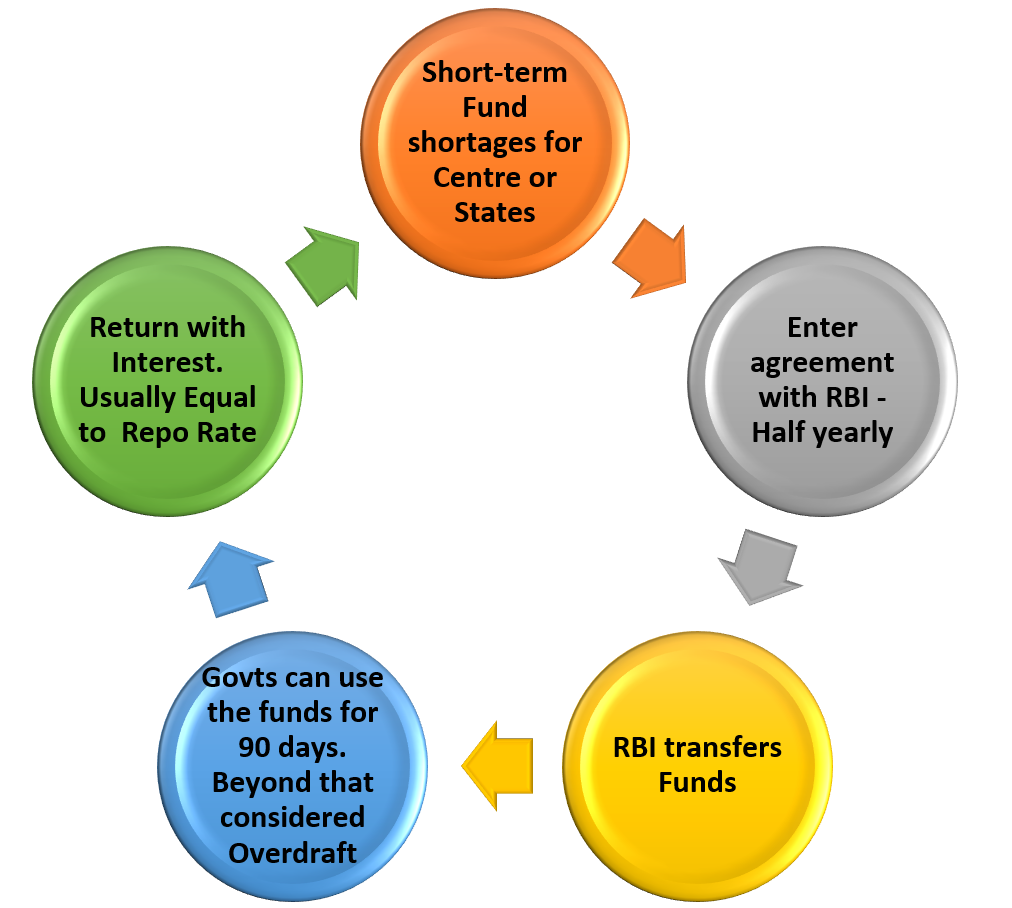
Ways and Means Advance
Why in News?
The Reserve Bank of India (RBI) has decided to continue with the existing interim Ways and Means Advances (WMA) scheme limit of Rs. 51,560 crore for all States/UTs upto September 2021, given the prevalence of Covid-19.
About Ways and Means Advances:
Launch: The WMA scheme was introduced in 1997.
Purpose: To meet mismatches in the receipts and payments of the government.
Features:
The government can avail immediate cash from the RBI, if required. But it has to return the amount within 90 days. Interest is charged at the existing repo rate.
Section 17(5) of the RBI Act, 1934 authorises the central bank to lend to the Centre and state governments subject to their being repayable “not later than three months from the date of the making of the advance”.
Repo Rate is basically the rate at which RBI lends short-term money to banks.
If the WMA exceeds 90 days, it would be treated as an overdraft (the interest rate on overdrafts is 2 percentage points more than the repo rate).
The limits for WMA (for Centre) are decided by the government and RBI mutually and revised periodically.
A higher limit provides the government flexibility to raise funds from RBI without borrowing them from the market.
Types:
There are two types of Ways and Means Advances — normal and special.
A Special WMA or Special Drawing Facility is provided against the collateral of the government securities held by the state.
After the state has exhausted the limit of SDF, it gets normal WMA.
The interest rate for SDF is one percentage point less than the repo rate.
The number of loans under normal WMA is based on a three-year average of actual revenue and capital expenditure of the state.
Significance:
The cash flow problems of States have been aggravated by the impact of Covid-19, thus many States are in need of immediate and large financial resources to deal with challenges, including medical testing, screening and providing income and food security to the needy.
WMA can be an alternative to raising longer-tenure funds from the markets, issue of State government securities (State development loans) or borrowing from financial institutions for shortterm funding. WMA funding is much cheaper than borrowings from markets.
Other Related Decisions:
The Special Drawing Facility (SDF) availed by State Governments/UTs shall continue to be linked to the quantum of their investments in marketable securities issued by the Government of India, including the Auction Treasury Bills (ATBs).
The annual incremental investments in Consolidated Sinking Fund (CSF) and Guarantee Redemption Fund (GRF) shall continue to be eligible for availing of SDF.
Auction Treasury Bills
These are money market instruments issued by the Government of India as a promissory note with guaranteed repayment at a later date.
Funds collected through such tools are typically used to meet short term requirements of the government, hence, to reduce the overall fiscal deficit of a country.
Consolidated Sinking Fund
CSF was set up in 1999-2000 by the RBI to meet redemption of market loans of the States.
Initially, 11 States set up sinking funds. Later, the 12th Finance Commission (2005-10) recommended that all States should have sinking funds for amortisation of all loans, including loans from banks, liabilities on account of National Small Saving Fund (NSSF), etc.
The fund should be maintained outside the consolidated fund of the States and the public account.
It should not be used for any other purpose, except for redemption of loans.
As per the scheme, State governments could contribute 1-3% of the outstanding market loans each year to the Fund.
The Fund is administered by the Central Accounts Section of RBI Nagpur.
Guarantee Redemption Fund
A Guarantee Redemption Fund (GRF) has been established in the Public Account of India from 1999-2000 for redemption of guarantees given to Central Public Sector Enterprises (CPSEs), Financial Institutions, etc. by the Union Government whenever such guarantees are invoked.
The fund is fed through budgetary appropriations with an annual provision in the Budget Estimates (BE).
On the recommendations of Twelfth Finance Commission, fifteen States have set up a Guarantee Redemption Fund.
This fund is maintained outside the consolidated fund of the States in the public account and is not to be used for any other purpose, except for redemption of loans. This ensures good fiscal governance.
